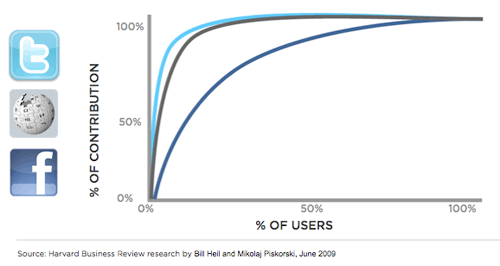In earlier articles, I outlined the unique characteristics of community, group, 2-way/symmetrical, and 1-way asymmetrical social relationships in online software. But do these distinct social models result in different user behavior?
Initially, contribution behaviors seem to hold steady across different social models. For example, if we look at status update creation in both Facebook (a large 2-way connection set) and Twitter (a large 1-way connection set), we see some similarities.
- 12% of all Facebook users update their status at least once a day (2-way model)
- 14.7% of all Twitter users post an update at least once a day (1-way model)
- 40.5% of Facebook users have updated status in past 7 days (2-way model)
- 49.6% of all Twitter users posted an update in past 7 days (1-way model)
Though the 1-way model on Twitter seems to have a slight leg up on Facebook’s 2-way model, this may be more a result of Twitter’s perceived purpose than anything else. However, when we look at where these contributions originate clear differences show up.
- 30% of production comes from 10% of users on a typical (2-way model) social network
- 90% of production comes from 10% of users on Twitter (1-way model)
There seem to be even bigger differences between community-based relationships and 2-way personal relationships. Comparing contribution page views (those responsible for creating a new content asset -photos, videos, events) to the total number of page views for a gvien Web site shows an interesting contrast.
- .0032% page views vs. video uploads on YouTube (community) worldwide
- 1.89% page views vs. content contribution (not counting status updates & comments) on Facebook (2-way model) worldwide
Though comparing page views in this manner is imperfect to say the least, the magnitude of difference (58,000% more contribution?) suggests there’s something worth paying attention to. In fact, a recent Harvard Business Review research article compared contribution across 2-way, 1-way, and community based sets. Their results found notable differences as shown in the graph below.
So do social models affect user contribution? Yes, contribution does seem to change as relationships get tighter. But there is more to it than that…
Coming Next…
In the next article about my Impact of Social Models talk, I’ll describe a few interesting findings that emerged when I compared contribution across these different social models.
